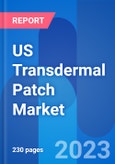US Transdermal Patch Market, Dosage, Price & Clinical Trials Insight 2029 Report Highlights:
- US Transdermal Patch Market Opportunity: > US$ 5 Billion By 2029
- Commercially available Patches In US Market: > 25 Patches
- Clinical Insight On All approved transdermal Patches In US Market
- Ongoing Clinical Trials Of Transdermal Patches in US: > 40 Patches
- US Transdermal Patch Clinical Trials Insight By Company, Indication & Phase
- Dosage & Price Insight Of Approved Patches By Indications
Competitive Landscape
Transdermal patches are an innovative means of delivering medications to the body and keeping medicine doses at the ideal levels required to treat an illness. The majority of transdermal patches on the market are reformulated versions of existing medications that are delivered orally or subcutaneously, and were produced after the patents on these drugs expired. In the US, the landscape of transdermal patch development is highly active, with contributions from both pharmaceutical corporations and researchers, who are now looking for creative ways to improve the features of these patches compared to conventional transdermal.
It is anticipated that over 100 clinical studies are being done globally to evaluate investigational transdermal patches, with approximately 50 of them taking place in the US. Neurological illnesses are currently dominating clinical trials in terms of indications. The most prospects are being developed for Parkinson’s and Alzheimer’s diseases. The number of people in the US suffering from neurological diseases has grown in recent years, as contributing environmental variables have increased in this age of modernization. With increased awareness of transdermal patches and their patient-friendliness, they are quickly becoming one of the most popular therapeutic interventions for these disorders. Transdermal patches are attracting interest in the US market for a variety of indications, particularly those that require long term treatment, such as cardiovascular disorders and chronic pain. The US is emerging as a hotspot for transdermal patch development, with many big and small companies executing clinical trials for transdermal patches created for various indications in the region.
Transdermal patches for pain relief are also an important field of study and development in the US. Aside from pain produced by joint difficulties, muscle strains, and nerve damage, among other things, researchers are focusing on pain caused by various health diseases such as cancer or its treatment, as well as pain experienced after specific surgeries. Transdermal patches release the drug at a steady rate over several hours, giving pain relief and serving as the most convenient alternative for pain reduction. Furthermore, unlike oral pain relievers, which can produce unpleasant events such as gastritis, transdermal patches have no substantial side effects.
Several medical universities and health centers in the US are also involved in the research and development of transdermal patches at present, and several of their products are now undergoing late phase clinical trials in the region. For instance, the Washington University School of Medicine is conducting a phase III trial for its buprenorphine transdermal matrix patch in pregnant patients with opioid use disorder. The aim of the trial is to see if the patch can induce opioid withdrawal in these subjects, which will determine the feasibly of the protocol of using patches as a bridge towards using sublingual buprenorphine films. Some others are the University of California, Davis and the Brown University that are conducting trials for oxybutynin and nicotine-based transdermal patches, respectively.
With the rapid approvals of transdermal patches lately, the FDA has also marked itself as an important player in the US market of transdermal patches. The FDA provides a detailed communication on the requirements of an ideal transdermal patch, and patches that meet these are allowed entry in the regional market. In September 2023, the FDA approved Zydus Lifesciences’ transdermal patch to prevent pregnancy. The patch is a generic version of a marketed hormonal patch and contains norelgestromin and ethinyl estradiol as its active ingredients.
The US transdermal patch market offers a plethora of opportunities encouraged by patient convenience, therapeutic versatility and the potential to address healthcare challenges such as pain management and vaccine administration. As technology continues to advance, and as patient preferences shift towards non-invasive and user-friendly drug delivery methods, the market for transdermal patches is expected to experience significant growth. Pharmaceutical companies and researchers are continuously exploring and investing in this field, which will continue in the coming years as well. In addition, as patent protection of some commonly used patches are coming to end, generic competition is expected to drive innovation in the market.
Table of Contents
1. Research Methodology
Companies Mentioned (Partial List)
A selection of companies mentioned in this report includes, but is not limited to:
- AbbVie
- AFYX Therapeutics
- Agile Therapeutics
- Bayer HealthCare Pharmaceuticals
- Corsair Pharma
- DBV Technologies
- Hisamitsu Pharmaceutical
- IBSA
- Privo Technologies
- Psilera
- Starton Therapeutics
- Teikoku Pharma USA
- Teikoku Seiyaku
- UCB
- Vaxess Technologiess
- Verndari








